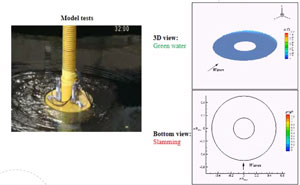Project 1: Renewable offshore energy - AMOS
Optimization and fault-tolerant control of offshore renewable energy systems
 Copyright Bjarne Stenberg/NTNU
Copyright Bjarne Stenberg/NTNUIn order to address fluid-dynamic loads/motions and structural response in severe waves, wind and current, this project will contribute with integrated mathematical modelling as a basis for design, analysis, control and optimization of wind turbine and wave energy converter parks. This enables coordinated and distributed optimization of wind parks, and fault-tolerant execution of the control strategies and integration with the electric grid. Floating wind turbines will have a strong nonlinear behaviour with large motions, global hydroelasticity, parametric resonances, and blade vibrations affecting the overall integrity of the structure, drive-train and the energy harvesting efficiency. Also the excitation of hydroelastic behaviour of bottom-fixed platforms in steep waves will be examined.
The outcome will be new holistic models and control strategies optimizing performance and robustness, low structural loading (maximum loading and fatigue) and turbine motions. Two different control strategies will be assessed; supervisory-switched control and model-predictive control (MPC). Decomposition based on time-scale separation into reduced complexity problems will allow different functions to be allocated; such as start and stop of wind turbines, limitation of fatigue and structural loads, frequency control, as well as reconfiguration in response to failures. Further outcomes will be: multi-domain system simulation software for both wind and wave energy systems, new concepts for integrated wind and wave energy parks with fish farms, new strategies for autonomous optimization-based predictive control of offshore wind and wave energy converters and parks, and demonstration and case studies based on simulations and laboratory experiments.
Project manager

Professor Jørgen Amdahl
NTNU Department of Marine Technology
Centre for Autonomous Marine Operations and Systems (NTNU AMOS)

